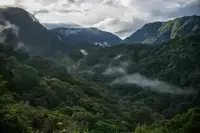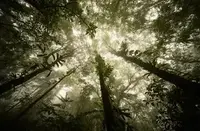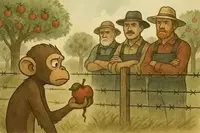Herping La Selva Introduction
For wildlife enthusiasts, La Selva Biological Station in Costa Rica is more than just a research hub—it’s a holy grail. Known for its dense rainforest, rare species, and a blend of accessibility and wildness, it’s one of the best places in the country to observe amphibians and reptiles in their natural habitat. This story chronicles my solo herping trip to La Selva in June 2025. Over the course of several nights and days, I hiked through primary and secondary forest, braved torrential rains, dodged territorial caimans, and photographed dozens of species—some familiar, others totally new to me. This wasn’t a vacation. It was a mission: to see what La Selva truly offers for nature photographers and field herpers like myself, and to decide whether it belongs on the list of ecolodges I recommend to travelers seeking wild encounters.
From Colorado to the Caribbean Lowlands
My trip to La Selva started at 1 a.m. in Colorado Springs, not with jungle trails or croaking frogs, but with a sleepy drive to Denver International Airport. I had booked an early morning flight with a layover in Dallas, planning to land in San José by the afternoon. My goal was to reach La Selva before dark. It’s always easier to navigate unfamiliar roads in daylight—especially when they wind through mountainous jungle terrain. But flight delays and circling off the Pacific coast (a pattern I’ve frustratingly come to expect from Costa Rica arrivals) quickly made it clear that daylight was slipping away.
Still, things moved quickly once we landed. Customs was smooth, and I grabbed my checked bag without issue. The big unknown was the rental car. I had reserved through Adobe, based on the glowing reviews from a local travel blog, but I’d been burned before by budget agencies in Costa Rica that pull bait-and-switch pricing scams.
To my relief, Adobe delivered. The rep was waiting right where the blog had said he’d be, holding a clipboard with my name on it. Within minutes, I was on the shuttle to their office. The car was clean, the paperwork straightforward, and best of all, the price was exactly what I’d been quoted. No surprises. No hidden fees. That in itself felt like a small victory.
But now came the part I was dreading: driving out of San José. It was rush hour, the streets were narrow and chaotic, and Waze became my lifeline. I drove with white-knuckled focus, threading through traffic and dodging impatient drivers. Only once I hit the toll booth for Highway 32—heading into the emerald folds of Braulio Carrillo National Park—did my pulse start to settle.
Of course, the highway had its own curveballs. Construction zones, minor accidents, and a police checkpoint all slowed me down. By the time I reached the Sarapiquí region, night had fully set in. I knew then I wouldn’t make it to La Selva in time for dinner, or even before reception closed.
I pulled off at a roadside soda just a few kilometers south of the station. The food was nothing special, but the owner was chatty and kind. When I told him I was in Costa Rica to look for wildlife, his face lit up. He told me how he’d helped a two-toed sloth cross the highway just days earlier and even showed me a faint scar where the sloth’s claws had scraped him. He knew enough to immediately scrub the wound clean, aware of the bacteria and infection risk—especially in a tropical environment. Sloths don’t have great defenses from predators but they do have some.
The soda owner enthusiastically described a small frog he had just seen in the parking lot shortly before my arrival and was eager to share his observation with me and perhaps get my help in identifying the species. After a bit of a back and forth conversation about the amphibian in question, I recalled seeing a very similar small frog from the Yatama ecolodge, a short distance away on a trip from two years ago, and suggested Pristimantis cruentus. I think we agreed this was the identity of his mystery frog.
It was one of those surreal but comforting moments that seem to happen only in Costa Rica: eating a basic meal, chatting about sloth safety, and swapping wildlife stories with a total stranger.
When I finally pulled into La Selva’s entrance, I was running much later than I had hoped—and a little worried I’d be spending the night in the car. But a guard was waiting at the front gate with a clipboard in hand. He scanned the list, found my name, and handed me a large envelope with keys, maps, and welcome instructions.
From there, I had to double back to a secondary entrance where the lodging area was located. Another guard greeted me, confirmed my arrival, and directed me to the parking area. I found my room, let myself in, and paused just long enough to snap a few photos of the clean interior—before my muddy boots and wet gear turned it into a field station.
And with that, I began preparing for my first night hike in the rainforest.
Cabin Life and Night One
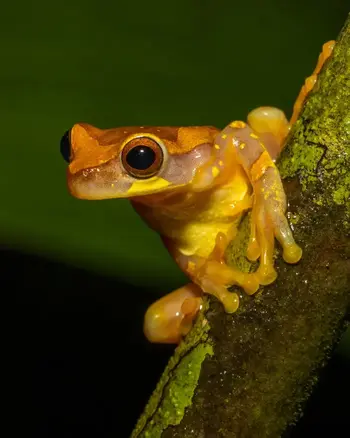
My accommodations were exactly what I expected—and wanted—from a rainforest ecolodge: clean, simple, and practical. Two large beds—one for sleeping, one for my photography gear—stood beneath two ceiling fans that kept the humid air moving. No air conditioning, which is typical and fine. The room had great airflow, which helped dry out clothing between hikes. A mini fridge was a welcome surprise, especially for keeping water cold.
Out back, a balcony overlooked the forest. It became my go-to spot for drying wet clothes and taking short breathers between excursions. One small but critical detail: the balcony door locked automatically. I made a mental note to never step outside without the key in my pocket. The last thing I wanted was to be locked out in my underwear with no one around.
The bathroom was basic but perfectly comfortable, and the shower offered both hot and cold water. The hot water came from a solar heater on the roof, which felt like the perfect blend of comfort and sustainability. The only downside was the location—about 1.5 kilometers away from the main campus where meals were served. Fortunately, I had a rental car, which saved my legs for the trails.
After settling in, I prepped my gear for my first hike. Even though I had just arrived, I couldn’t bear the idea of wasting a night. I studied the map and headed out solo into the rainforest with nothing but my flashlight and camera.
A Guided Tour, a Curious Boy, and a Day of Wildlife
The next morning started with breakfast at the cafeteria. Meals at La Selva are served in a large communal dining hall. It’s cafeteria-style—food already prepared and portioned out by staff behind the counter. There were always meat and vegetarian options, fresh fruit, juice, and coffee. The food was good—not fancy, but nourishing and hearty. Just what you want before a long day on the trails.
As I was finishing my plate, a man from reception came to remind me that my stay included a guided tour. He told me to meet my guide just outside the office after breakfast. I was the only overnight guest on the tour, and we were waiting on a family who had signed up for the day. While we waited, the guide and I walked a few trails around the main campus. He gave me a broad overview of the station, pointing out maps and describing the layout of the trails.
La Selva, he explained, protects over 1,600 hectares of forest, and 63% of that is old-growth primary rainforest. That stat alone floored me. Most of the preserved forest in Costa Rica (and around the world) tends to be mountainous, where agriculture is less viable. Lowland rainforest, with its agricultural suitability, is harder to protect. But here it was—lush, healthy, and still standing. He pointed to a map showing how La Selva connects via a corridor to the highlands of Braulio Carrillo National Park. It’s not just a preserve—it’s a bridge for species that migrate along elevation gradients.
Soon the family arrived—a mom, a dad, and three kids—and we set off on our tour. Almost immediately, the youngest son broke away from his family and walked beside me. He had a reptile field guide in hand and clearly sized me up as a fellow herp nerd.
“Hey Mike,” he whispered. “Have you ever seen a fer-de-lance?”
I smiled. “Yeah, a few times.”
A minute later, he was back with another question. “Hey Mike, have you ever seen a green and black poison dart frog?”
"Absolutely, little man. I've seen several of them!"
This continued for most of the hike. His mom would occasionally try to reign him in—“Oh leave the poor man alone!”—but I didn’t mind. His enthusiasm was pure, and honestly, I saw a lot of my younger self in him. He reminded me of the boy in Jurassic Park who bombards Dr. Grant with his questions.
As a group, we had a productive hike. We saw all three monkey species that live at La Selva—howlers, capuchins, and the endangered spider monkeys. Squirrel monkeys don’t occur in this region, so seeing the “big three” was a great outcome. We also spotted a three-toed sloth, a broad-billed motmot, and a beautiful yellow-phase eyelash viper perched off-trail. Too far for good photos, but still an exciting find.
The kids were on a roll. One of the boys spotted a green and black poison frog (Dendrobates auratus), and the youngest—my sidekick—found a small snake on the trail. The guide and I initially thought it was a juvenile salmon bellied racer, but after posting to inat, I realized it was a graceful brown snake (Rhadinaea decorata).
Later in the hike, we entered a section of primary rainforest. The difference was clear. Giant trees spaced wide apart, an open understory dominated by palms, and a kind of stillness that only comes with age. We passed a sign marking the entrance to a research-only swamp trail. Knowing my background and interests, the guide told me it would be okay if I entered at night, despite the sign declaring access was granted to researchers only.
He also mentioned another swamp area that was currently closed. Apparently, a mother caiman with babies had been mock-charging anyone who got too close on the boardwalk. While not a real danger, it was enough to justify giving her space.
We wrapped up the tour with lunch and a few more dart frog sightings—Oophaga pumilio, mostly—then parted ways. The tour had been more enjoyable than I expected. I usually prefer solo exploring, but having an experienced guide and an energetic kid tagging along made for a surprisingly memorable day. For those of you who are like me and prefer the challenge and adventure of unguided wildlife viewing, I still strongly recommend taking advantage of this free guiding service to help fill up your camera's card with keepers, as well as getting a bit of insider info on the "how", "when", and "where", of herping La Selva.
Rainfall and Rare Moments
That night, the rain started just after dinner. I didn’t have a poncho with me—something I’d forgotten in the rush to pack—but I wasn’t about to let a little tropical downpour stop me. Besides, warm rain in the rainforest doesn’t bother me. It’s part of the experience.
The frogs loved it. Their calls multiplied by the minute, echoing from the trees and the marshes. I revisited the trail to the researcher-only swamp. This time, the frog activity was explosive. I spotted red-eyed tree frogs (Agalychnis callidryas) at eye level—no longer just calling from high in the trees. Leptodactylus, Scinax, Smilisca, Craugastor—they were all out.
Then came the highlight of the trip.
While hiking a trail through the primary forest, I spotted another yellow eyelash viper. At first glance, I thought it was resting in an ambush pose, draped across a low palm trunk. But something looked off. I moved in closer and saw it had a frog in its mouth—an hourglass tree frog (Dendropsophus ebraccatus), evidently shortly after initial strike.
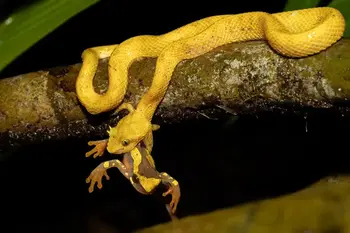
Predation events like this are rare to witness, and are the ultimate wildlife photography moments. I slowly backed off to avoid spooking it, retrieved my camera gear, and returned to document the moment. The snake seemed unfazed, and I managed to get several shots before leaving it to finish its meal. I was beyond thrilled! That single encounter made the entire trip worth it.
In the following days, I revisited the snake at the same palm and observed that it was moving from position to position within the palm. From high to low, exposed to concealed. While eyelash vipers are known to wait in one particular spot for many days at a time, I assumed this snake was frequently changing its position to optimize thermoregulation to digest its meal. While I never observed it moving during the day, it clearly was doing so.
The Final Days and a Surprise Caiman
The rains brought out more frogs—and a couple of snakes I definitely didn’t want to miss. I turned up two fer-de-lance (Bothrops asper) over the next few nights: one juvenile, and one large, actively foraging adult. Normally, I’d have a snake hook with me for exactly this kind of moment. It’s not for handling the snake, but for gently coaxing it into a photogenic coil if it’s on the move and about to disappear into the forest. But La Selva has a strict no-manipulation policy, and out of respect for that—and for the access they generously offer to solo herpers like me—I always left my hook in the room. That meant I had to get creative.
The adult fer-de-lance was moving alongside the trail when I spotted it. It was moving, fast enough that if it decided to go downhill, I’d lose it into the undergrowth in seconds. I needed it to stop and coil—or I’d get no shot at all. Thinking quickly, I used my backpack and body position to gently guide it toward the uphill side of the trail. Snakes generally struggle more with uphill travel, and sure enough, after a few hesitant climbs, it gave up and settled beneath a broad-leafed understory plant, perfectly coiled. It was exactly the kind of shot I hope for—face visible, body in frame, beads of rain catching the light on its scales—and I got it without ever needing to touch or manipulate the snake. That’s the shot you see at the top of this article—the result of a little patience, positioning, and one very cooperative pit viper.
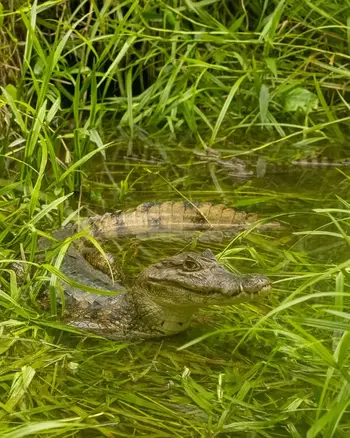
Other notable herp observations include Boana rufitela, Rhaebo haematiticus, Incilius melanochlorus, Agalychnis salvator, a black river turtle, and several more Craugastor species. During the day, I observed green iguanas, anoles, basislisks, the two poison frogs (O. pumilio and D. auratus) and birds like toucans, macaws, and the Montezuma oropendola. One even mimicked the sound of crashing branches—a weird and surprisingly convincing vocal trick.
On my last day, I learned from another guest that the caiman trail had reopened. She even showed me photos of the mother and her young. I wasn’t planning to hike that morning, but I couldn’t resist.
When I reached the trail, the tape was still up, but I guessed they hadn’t removed it yet. Moving slowly and respectfully, I made my way into the marsh. I counted several caiman of different sizes, and eventually found the mother guarding her young. She watched me closely, head raised, and I knew exactly what to expect if I moved an inch closer. But out of respect for this diligent mother, I took a single (not so great) photo, backed off, and left the marsh.
Species Observed at La Selva
Partial list of species observed.
Amphibians (Class Amphibia)
Frogs & Toads (Order Anura)
- Red‑eyed Tree Frog (Agalychnis callidryas)
- Parachuting Red-eyed Leaf Frog (Agalychnis saltator)
- Red‑webbed Tree Frog (Boana rufitela)
- Drab Tree Frog (Smilisca sordida)
- Olive Snouted Tree Frog (Scinax elaeochrous)
- Hourglass Tree Frog (Dendropsophus ebraccatus)
- San Carlos Treefrog (Dendropsophus phlebodes)
- Strawberry Poison‑Dart Frog (Oophaga pumilio)
- Green‑and‑Black Poison‑Dart Frog (Dendrobates auratus)
- Slim-fingered Rain Frog (Craugastor crassidigitus)
- Atlantic Broad-headed Litter Frog (Craugastor megacephalus)
- Savage’s Thin‑toed Frog (Leptodactylus savageii)
- Leaf Litter Toad (Rhaebo haematiticus)
- Cane Toad (Rhinella marina)
- Tink Frog (Diasporus diastema)
- Narrow‑mouthed Toad (Hypopachus pictiventris)
Reptiles (Class Reptilia)
Snakes (Order Serpentes)
- Fer‑de‑Lance (Bothrops asper)
- Eyelash Viper (Bothriechis nigroadspersus)
- Ornate Cat‑eyed Snake (Leptodeira ornata)
- Blunt‑headed Tree Snake (Imantodes cenchoa)
- Adorned Graceful Brown Snake (Rhadinaea decorata)
Lizards (Order Lacertilia)
- Green Iguana (Iguana iguana)
- Anole species (Anolis spp.)
- Green Basilisk (Basiliscus plumifrons)
Turtles (Order Testudines)
- Black River Turtle (Rhinoclemmys funerea)
Birds (Class Aves)
Various Orders
- Great Green Macaw (Ara ambiguus)
- Scarlet‑rumped Tanager (Ramphocelus passerinii)
- Yellow‑throated Toucan (Ramphastos ambiguus)
- Broad‑billed Motmot (Electron platyrhynchum)
- Semiplumbeous Hawk (Leucopternis semiplumbeus)
- Montezuma Oropendola (Psarocolius montezuma)
- Parakeet species (e.g. Aratinga)
- Guatemala Screech Owl (Megascops guatemalae)
Mammals (Class Mammalia)
Various Orders
- Three‑toed Sloth (Bradypus variegatus)
- White‑nosed Coati (Nasua narica)
- Collared Peccary (Pecari tajacu)
- Agouti (Dasyprocta punctata)
- Raccoon (Procyon lotor)
- Southern Opossum (Didelphis marsupialis)
- Tayra (Eira barbara)
- Various small rodents
Final Thoughts
La Selva exceeded my expectations. The forest was vibrant, the herping and widlife viewing excellent, and the experience felt genuinely wild despite the station’s infrastructure. The paved trails, which I feared would feel too artificial, actually helped preserve the surrounding habitat by keeping foot traffic contained. And they made walking easier, allowing me to keep my eyes on the trees and leaf litter—not my footing.
But more than that, La Selva reminded me of why I fell in love with herping in the first place. The thrill of discovery. The moments of stillness. The occasional child who won’t stop asking questions about snakes.
It’s not just a great place to see wildlife. It’s a place that lets you be wild—just enough to remember who you are.

